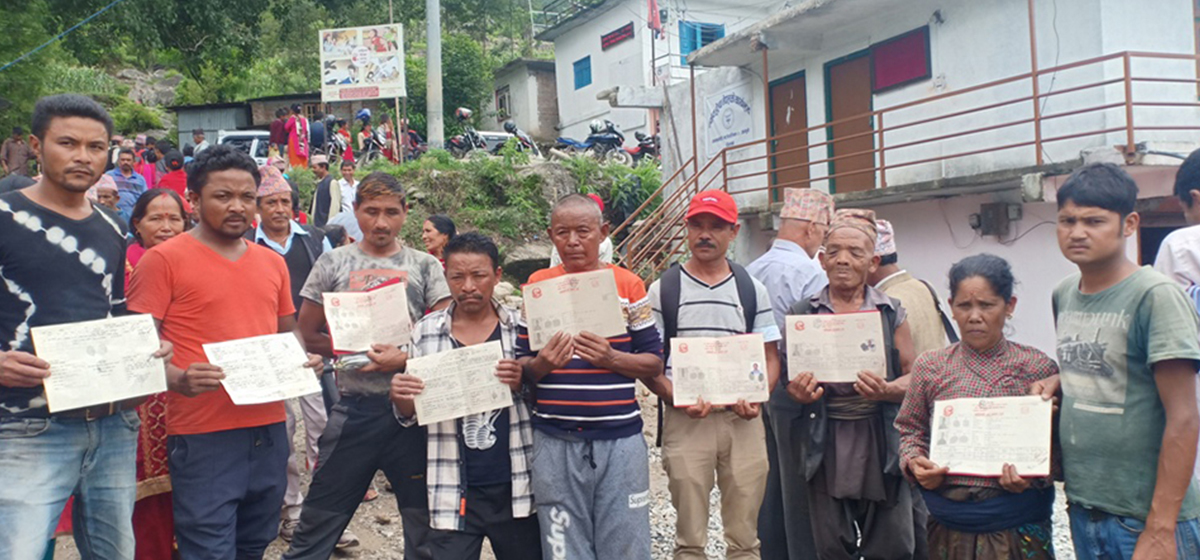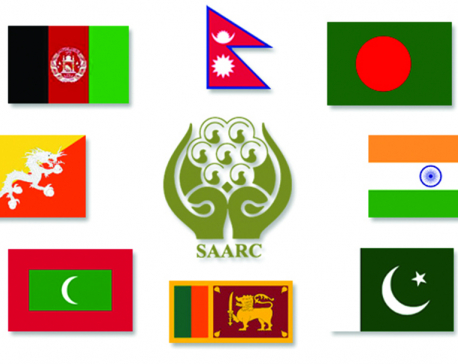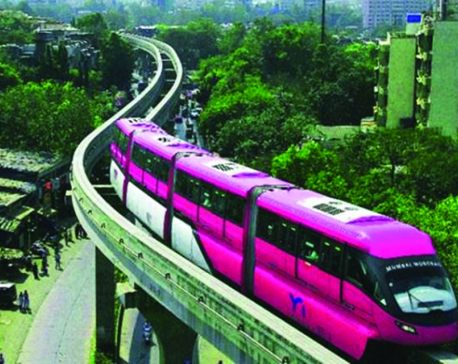
OR
Opinion
Solving Landless People Problem in Nepal
Published On: September 9, 2021 08:30 PM NPT By: Keshav Bhattarai

Within the past three decades, different governments have constituted nine commissions led by 17 chairpersons to solve the LDDPS’ problems. These commissions have distributed 45,964 bighas of forest lands to 54,854 families but the problem has become further complicated.
The problem of landless, Dalits, and displaced peoples’ (hereinafter referred to as LDDPS) settlement has been one of the major vote-garnering agendas for Nepali politicians in every periodic election and in events when political crises loom. Since the practice of LDDPS’ safe settlements in Nepal started with a bad precedent, it has become a never-ending issue. It needs a doable, cost-effective, apolitical, and non-controversial solution to end this ill-famed political tool and truly serve real LDDPS. The bad precedent started from the establishment of the Nepal Resettlement Company (NRC) in the early 1960s. Despite having clear objectives like the Kibbutz system of Israel to start with the settlements of military people who retired from the Indian Army along the Nepal India border as envisioned by BP Koirala assisted by Bakhan Singh Gurung with the first settlements in Chitwan district, overtime the NRC’s objectives were polluted by the motives of clearing the dense Tarai forests in the name of malaria eradication. The royals and the Panchayat rulers continued with the wrong traditions of the Ranas who granted large swaths of the Tarai forests to their kith and kin including their relatives from India. These forest land receivers found the ongoing railway constructions along the neighboring states of India as lucrative markets for Nepal’s Tarai hardwood. Over time, the Tarai forests were used as personal coffers by royal coteries to entice and/or decimate opposition political parties. Panchayat rulers used the Tarai forest lands to entice political leaders mostly from the left wing into the Panchayat system. Indeed, a saying is still common in Nepali society that during the Back to the Village National Campaign, “Kangresee Benaras base, Communist Panchayat Pase.”
Likewise, a few elites in the hill and mountains who were defamed for their misdeeds including extramarital affairs also left their natal homes for the Tarai and grabbed forest lands imitating pro-Panchayat workers. I vividly remember the songs during my childhood days, “Gaunko Bapati, Jharyo Rapati, Bhayo Sabhapati.” Simply put, the so-called resettlement of LDDPS started with evil intentions despite its well-defined objectives. The true LDDPS rarely received any respite from periodic resettlement schemes and their problems magnified each year that sprung like a Palestine’s intifada. The bad tradition continues till today without serving the LDDPS. Nepal-based UNDP states that of the 5.82 million families of Nepal, 24% are landless. Over 77% of the families have less than 2 ropanis of land each. Nepal’s 2011 census shows 13% Dalits in Nepal of which 44% are Madhesis and 15% are Pahadis. The Ministry of Land Reform and Poverty Alleviation in 2020 stated that almost 1.5 million families are identified as landless of which a million belong to the Dalit and the so-called lower caste people. In every periodic election until the final vote counts are done, these LDDPS became the attractive masses who are provoked to pelt stones and use weapons in some circumstances against the opposition and chant slogans in favor of someone who assures them government land.
What has been done to solve these problems?
Within the past three decades, different governments have constituted nine commissions led by 17 chairpersons to solve the LDDPS’ problems. These commissions have distributed 45,964 bighas of forest lands to 54,854 families but the problem has become further complicated. Recently, the opposition parties have found the dissolution of Gyawali-led Landless Peoples’ Settlement Commission (LPSC) as one of the major contentious issues. No doubt, the opposition parties have a sensitive issue on hand because Article 40 (5 & 6) of the Constitution of Nepal 2072 states that Nepal Government will constitute landless peoples’ resettlement commission to settle LDDPS. The Gyawali Commission was assisted by 1,700 field workers including three office-bearers in each of the 77 districts numbering 231, and each drawing a salary and perk equivalent to the special class secretary and joint secretary. Within 16 months, the Gyawali Commission spent Rs 210 million and has claimed that it has gathered information of 247,960 landless and 32,801 unorganized settlers from 319 urban and rural municipalities. The commission had planned to settle 400,000 landless and 1.3 million unorganized settlers on forest lands.
The contentious debate ramified
The opposition parties’ leaders have labelled the dissolution of the Gyawali Commission by the Sher Bahadur Deuba government as an insensitive and self-serving action despite the burning issues of LDDPS. No doubt, land allocation plays key roles in bringing desirable improvements in the livelihoods of people because land possession is considered as an effective mechanism for upward mobility. Land allocation to LDDPS may address the problems of food insecurity, resource disparity and poverty since it helps the poor to engage in wealth creation. Min Bishwakarma of the Nepali Congress, however, denies the allegation of insensitiveness and self-service leveled against the SB Deuba government and argues that a commission made to serve the Dalits has no Dalit representation except 3 Dalit chairs out of 77. The ugly blame game debates continue.
What can be done?
Let us not waste time to offer respite to these LDDPS and solve this problem within a year and call it a solution once and for all. First, make a firm land-use policy to clarify who should have the ownership of land allocated to LDDPS. Second, ask for applications from LDDPS with certain deadlines and utilize the list gathered by the Gyawali Commission if the claim is true. Third, verify the list of LDDPS from the 77 district-based land revenue offices to verify the right LDDPS. Fourth, engage the human power of district-based forest offices. Provide a desk-top computer with required specifications to operate ArcGIS Pro or QGIS and Google Pro and 4-5 global positioning units (GPS) per district. Assist these offices with fast internet services. Train the forestry personnel to identify land areas available for safe settlements within their jurisdictions. Fifth, get digital land parcels from the Survey Department. If privacy becomes an issue to share these land parcels, depute survey officers to overlay these parcels on the district and municipal maps and cross-check with the identified land areas by forestry personnel for safe settlements of LDDPS. Sixth, call a conference under the convenorship of the respective chief district officers involving everyone concerned. Seven, engage the peoples’ representatives of all levels to inform which land areas will be used for safe settlements. Eigh, assess the suitability aspects of land for safe settlement taking into consideration the changing climate context using the personnel from various government agencies such as irrigation, roads, urban planning, local development offices. Nine, take help of ICIMOD if need be. Ten, once land is identified, cross-validate the identity of LDDPS to assure that they are the qualified candidates for settlements. Eleven, organize several meetings, announce the names of the identified LDDPS candidates publicly asking for complaints, if any. Twelve, distribute land certificates to LDDPS. Thirteen, circulate copies of these land certificates of the LDDPS receivers to 77 districts to cross-check if any mistakes have been committed. Fourteen, once all hurdles are cleared, help settle these LDDPS getting loans from development agencies. Fifteen, it is time to start with communal farming and planning for smart cities.
Question may arise
Where are the skilled manpower, software, computers, and internet facilities? All these can be done within Rs 50 million as opposed to Rs 210 million spent within 16 months by the Gyawali Commission. Additionally, this step will not only equip the district-based offices and encourage personnel to develop new skills, but this will also be an opportunity for Nepal to demonstrate a model how humanitarian crises are resolved in an amicable manner. I share this experience from Dorna P Acharya and Shailaja commissions, which received the least complaints despite the fact that it was a period of pen and paper without digital technology. The Shailaja Commission received 263,738 applications. In cross-verifications, many were found ineligible. Those found eligible and settled in Bardiya district had zero complaints. The lesson learned was that when true LDDPS were not seen from any political lenses but looked from the humanitarian ground, the proverb of ‘zero defects, zero affects’ comes true. It is high time the Deuba-led government considered these two cents’ ideas and subjected them to severe scrutiny.
(The author is a professor of Geoscience at the University of Central Missouri, USA)
You May Like This

Free the SAARC
India is actively distancing from SAARC thinking that it is no longer an effective body to maintain influence in the... Read More...

Why monorail is bad for Kathmandu
One of the biggest downsides of monorails is when something goes wrong, or if a section of track needs to... Read More...

Learn from China
China is rising to superpower status in 40 years after Deng Xiaoping initiated reforms. We have lost 30 years of... Read More...




Just In
- Govt receives 1,658 proposals for startup loans; Minimum of 50 points required for eligibility
- Unified Socialist leader Sodari appointed Sudurpaschim CM
- One Nepali dies in UAE flood
- Madhesh Province CM Yadav expands cabinet
- 12-hour OPD service at Damauli Hospital from Thursday
- Lawmaker Dr Sharma provides Rs 2 million to children's hospital
- BFIs' lending to private sector increases by only 4.3 percent to Rs 5.087 trillion in first eight months of current FY
- NEPSE nosedives 19.56 points; daily turnover falls to Rs 2.09 billion
















Leave A Comment